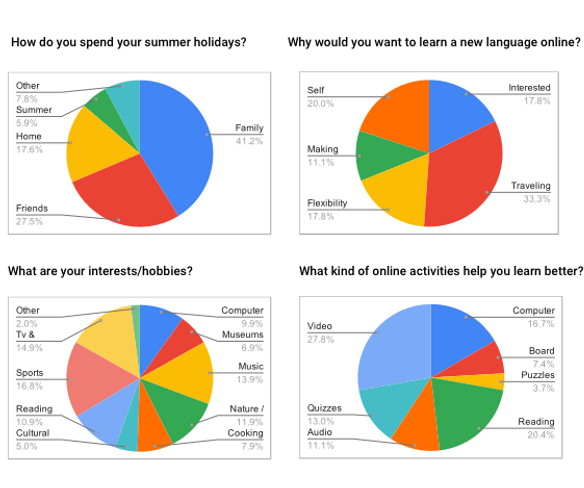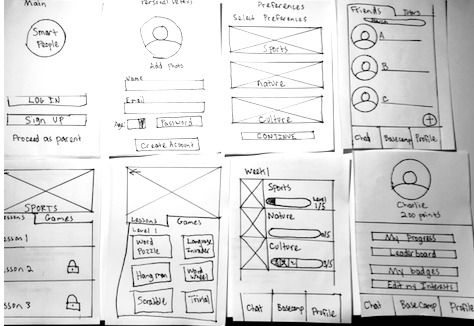The project, working in pairs is about creating an online learning platform that transforms the in-person learning experience into a 100% digital experience.

THE PROBLEM
Smart People Inc. needs a way to provide an engaging online learning experience for students that cannot attend Summer Camp. The design sprint of 5 days focused on creating an MVP of an App using the design thinking process and deliver a mid-fidelity prototype.
THE RESEARCH
During the research phase, we completed the following in order to understand the problem better before starting to design the online learning platform.
A competitor analysis of Language Apps and Online Summer Camps already in existence provided insights to the current market. It turns out that Smart People, Inc has a unique opportunity.
User Survey
A survey was sent out to gather information on the user needs, pains and goals regarding learning a new language. We wanted to know which types of activities help adolescents to learn and types of interests.
Competitor Analysis

A sample of the survey questions and results


Affinity Diagram
An affinity diagram summarized the main findings from the user survey.
Empathy Map
We used the affinity diagram to help create an empathy map to summarize the key attributes for the "Smart People" online learning platform

User Persona
The research phase gave us a better understanding of the business and types of users of an online learning platform and at this point we created a primary user persona and defined the "How Might We" statement.

“I learned that staying at home is boring and that I should go outside more but I don’t know where to."
How Might We

THE IDEATION PHASE
Moscow Method
The Moscow Method helped determine which features and ideas that must be included in the prototype. The final product would only include the “must have” and “should have” to prioritize the most important elements for the business and the user.
Card Sorting
This phase also included Open Card Sorting to determine names of the categories for navigating the online learning platform.

Information Architecture
Site Map for Navigation
DESIGNING THE APP
Low-Fidelity Wireframes
The site map and primary persona provided clues to how a low-fidelity paper prototype would continuously be revised during testing and iterations.

A Sample of Low-Fidelity Wireframes
MID-Fidelity Wireframes
After intensive testing of the Low-Fidelity paper prototype, we continued to change components until navigation became clear and the project could move onto creating mid-fidelity wireframes in Sketch for the interactive prototype.

A Sample of Mid-Fidelity Wireframes
Interactive Prototype
The user signs-up for the online learning camp and creates a user name and password. The user chooses their preferences, which are aligned with their interests before being able to explore the App.
Our prototype in the video tours each section: Walkie Talkie, Base Camp and Camper Profile. The camp structure of 4 weeks is equivalent to 4 levels and each level represents 1 week of exercises, quizzes, videos and games. The platform design requires the user to complete each level in 1 week, so the minimum time to finish 4 levels is 4 weeks.
Key Learnings and Next Steps
This fictional project distanced itself from the original project brief. However, we did apply the design process throughout the entire project and integrated what we learned so far from the Ironhack Bootcamp. In retrospect, we should have created a more genuine "Summer Camp" experience.
The next steps include intensive testing for easy navigation, develop wireframes for the parent's user flow and ideate for a more inclusive "Summer Camp" experience. Overall, we were very satisfied with the outcome of the project and learned, applied the concepts of UX Design.
This project was completed in collaboration with Joao Campos. https://medium.com/@johnnyfields